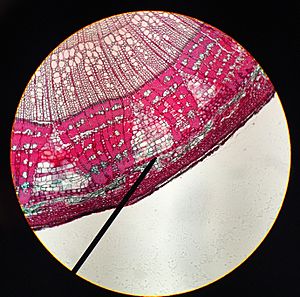Cork cambium facts for kids
The cork cambium is a special part of many plants, like trees and shrubs. It's a layer of cells found in the bark, which is the tough outer skin of a plant's stem and roots. Think of it as a growth layer that helps the plant get wider and stronger.

The cork cambium is a type of meristem. Meristems are like the plant's "growth zones." They contain young, unspecialized cells that can divide and grow into different parts of the plant. This cork cambium helps the plant grow thicker, replacing its outer skin (epidermis) as it expands.
You can find cork cambium in many woody plants, like trees, and also in some other plants. It's one of the many layers that make up the bark. Its main job is to create cork, which is a strong, protective material.
Other names for cork cambium include bark cambium, pericambium, or phellogen.
Why is Cork Cambium Important?
The cork cambium is very important, not just for plants, but also for us!
- Commercial Cork: The cork we use every day comes from the bark of the cork oak tree (Quercus suber). This amazing material is used for many things, like stoppers for wine bottles, bulletin boards, and coasters. It's also great for insulation, sealing lids, flooring, and even handles for tennis rackets.
- Mulch: Many types of bark, produced by the cork cambium, are used as mulch. Mulch helps keep soil moist, controls weeds, and adds nutrients to the garden.
Other Pages to Explore
Images for kids
-
The bark of a cork oak tree (Quercus suber) in Portugal.
See also
 In Spanish: Felógeno para niños
In Spanish: Felógeno para niños


